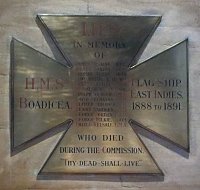Location
This plaque in the form of a Maltese Cross is in the body of the church. It is on a rear wall facing East.

In Memory of
HMS Boadicea
Flag Ship
East Indies
1888-1891
James Erskine, Lieut
Wm Aug Harvey, Secty
Thomas Stubbs, Smith
Edwd Cotter, Ch Yeo Sigls
Ben J McAnnally GMA
Wm Matthews, Grs Mate
Joseph Younger, GMA
David Buchanan, AB
Alfred Shilvock, AB
Henry Wardley, AB
George Jordan, AB
George Wilkie, DOM
Fred G Kelsall, GMA
'Who died during the Commission
Thy dead shall live'
Further Information
The "Boadicea" referrred to in this plaque was the third of that name. She was a 16-gun screw corvette, launched at Portsmouth in 1875 and was of 4,140 tons, 5,290 horsepower and 14.9 knots speed. Her length, beam, and draught were 280ft, 45ft, and 24ft. In the early part of her career the Boadicea took part in the Zulu War. 16 of her officers and 378 men under Commodore Francis Romilly supplemented the Naval Brigade at the battle of Ginginhlovo.

In 1881 the Broadicea had assisted in the first Boer war by the landing of the Naval Brigade. On January 6th 128 officer and men, two machine guns, and a couple of rocket tubes proceeded to the front, again under Commodore Francis Romilly. There is a memorial to the men who fell on this campaign on private land just outside Majube in Kwazulu Natal (see right). The inscription reads "IN MEMORY OF THE OFFICERS AND MEN OF THE NAVAL BRIGADE FROM H.M.SHIPS "BOADICEA" AND "DIDO" WHO FELL AT LAING'S NEK AND MAJUBA HILL ON THE 28 OF JANUARY AND 27 FEBRUARY 1881". [Info and photo Alec Lloyd]
The service referred to above began in 1888 when the Boadicea, commanded by Captain the Hon. Assheton Curzon Howe, and flying the flag of Rear Admiral the Hon. Edmund Fremantle, was at the head of a fleet of seven English vessels and one German ship taking part in the blockade of the Zanzibar Littoral. This action was associated with the suppression of slavery but was generally uneventful. On November 6th the Boadicea's pinnace, commanded by Lieutenant Walter Clifton Slater, captured a large slave dhow off Pemba. It had 41 slaves on board, and was not brought to until shots had been shot on both sides.
In September 1890 nine German traders were murdered in Vitu, a small state about 230 miles north of Zanzibar. On October 24th the boats of the Boadicea under Captain the Hon. Assheton Curzon Howe, and those of two other ships, proceeded to Baltia and burnt the village. On October 26th a Naval Brigade of 700 seamen and marines were landed under the personal command of Vice-Admiral the Hon. Edmund Femantle. Meeting with some brisk resistance en route, the expedition captured the town of Vitu on October 27th, Gunner George Alfred Jenning, of the Boadicea blowing up the town gate with gun cotton. The town and the Sultanís house were burned, and the brigade returned to their ships, having lost 12 men wounded and developed several cases of sunstroke. Captain the Hon. Assheton Curzon Howe was made a C.B. for this service. In 1905 the Boadicea was broken up.
Captain Curzon Howe later became Port Admiral at Portsmouth, dying whilst in command on March 1st 1911. The Corporation commemorated him by naming a street which replaced many of the slums in Portsea after him. Curzon Howe Road exists today and is adorned by a plaque celebrating the clearance of the slums.
Photos of HMS Boadicea can be seen at www.battleships-cruisers.co.uk/bacchante_class.htm
